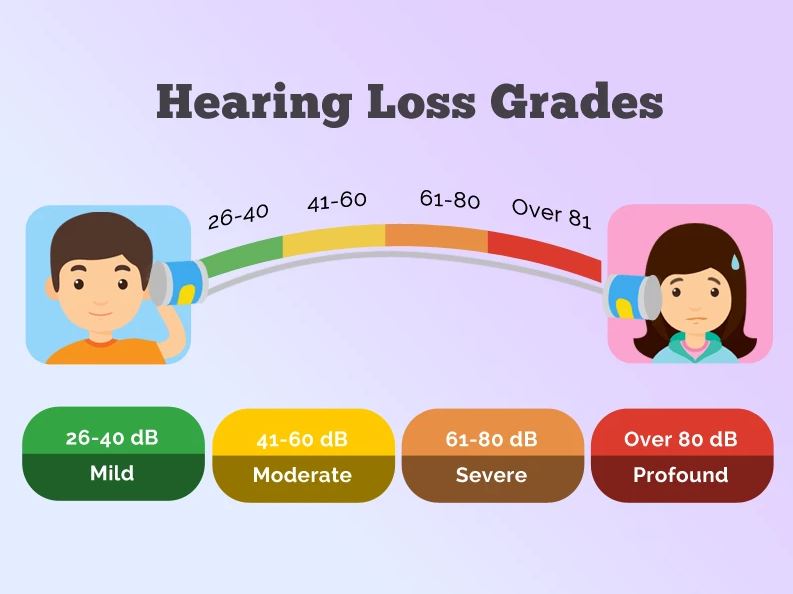According to the statistics of the World Health Organization, over 5% of the world population has disabling hearing loss. Moreover, it has been estimated that by the year 2050 around 10% of the human population will have disabling hearing loss. This huge number makes it imperative for us that we acquire some basic understanding of deafness and hearing loss in general. So, here is a fact sheet to make you aware of disabling hearing loss and how it impacts us.
What Do We Mean by Disabling Hearing Loss?
Disabling Hearing Loss is a condition where hearing loss is greater than 40dB in an adult in the better hearing ear. In a child, if the hearing loss is greater than 30dB then the child will be said to have a disabling hearing loss. A hearing loss is categorized as mild, moderate, severe and profound based on the person’s ability to hear or not hear a certain decibel of sound. It can affect any or both of the ears.
A person who falls in the range between mild to severe is said to be ‘Hard of Hearing’. People who are hard of hearing usually communicate through spoken language and can benefit from hearing aids or cochlear implants. People with profound hearing loss are mostly deaf and they need to rely on sign language for communication.
What Causes Deafness or Hearing Loss?
Lots of factors can cause deafness or hearing loss. All those causes can be broadly classified as – Congenital or Acquired.
Congenital causes of deafness or hearing loss may include the following factors –
- Infections like syphilis or maternal rubella acquired during pregnancy
- Low birth weight of the baby
- Lack of Oxygen at the time of birth, also known as birth asphyxia
- Inappropriate use of certain drugs during pregnancy
- Severe jaundice during the neonatal period
- Some hereditary or non-hereditary genetic factors

Causes of acquired deafness or hearing loss may include the following factors –
- Infectious diseases like mumps, meningitis and measles
- Chronic ear infections
- Otitis media or the collection of fluid in the ear
- Injury to the head or ear
- Exposure to excessive and prolonged noises
- Degeneration of sensory cells due to ageing
- Wax or some foreign body blocking the ear canal
How Can We Prevent a Hearing Loss?
It is important to note that a few simple strategies can help in preventing hearing loss. If we are informed enough we can prevent at least some cases of hearing loss. Here are the things that should be kept in mind.
- Children should be immunized against childhood diseases including mumps, measles, rubella, meningitis etc.
- Women of reproductive age should be immunized against rubella before pregnancy.
- Pregnant women should maintain proper hygiene in order to prevent any infections during their pregnancy.
- Safe childbirth practices should be promoted. Delivery should be done in the proper care of qualified doctors and medical practitioners.
- We all should follow healthy ear care practices.
- We should prevent ourselves and others from the harmful exposure to loud and prolonged noises by creating awareness about the harmful effects of loud noise. One should stay away from loud occupational as well as recreational sound.
- Children should be screened for otitis media and should be provided the required medical intervention.
Even if a child is born with a condition of hearing loss, an early detection, medical intervention and proper management can minimize the impact of hearing loss. If the child is born with deafness, she should be trained in sign language with her family from the very beginning. To help any child with deafness or hearing loss, an early occupational screening for ear diseases and hearing loss is very important.
Use the citation below to add this article to your bibliography
"Deafness and Hearing Loss: A Fact Sheet." Wecapable.com. Web. April 25, 2024. <https://wecapable.com/deafness-hearing-loss-facts/>
Wecapable.com, "Deafness and Hearing Loss: A Fact Sheet." Accessed April 25, 2024. https://wecapable.com/deafness-hearing-loss-facts/
"Deafness and Hearing Loss: A Fact Sheet." (n.d.). Wecapable.com. Retrieved April 25, 2024 from https://wecapable.com/deafness-hearing-loss-facts/

Leave a Reply